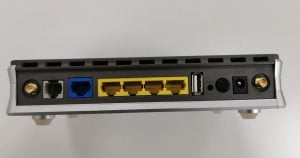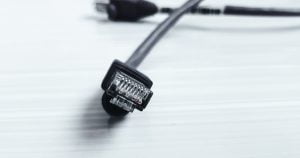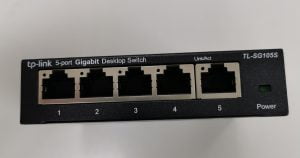You will almost never reach your maximum advertised broadband speed on a contended line. This is why providers usually offer guaranteed minimum speeds, which on Gigabit connections can reach 200Mbps and even more.
But what if you are not even getting your guaranteed speed? In some cases this might be the fault of the supplier but often not. It is very likely your hardware is not capable of handling speeds past a certain threshold if you have not upgraded it in the recent decade.
We will look at what broadband speed is, why it is important and you want to get the most out of it and how you can set yourself up to have maximum benefit from your new Gigabit connection.
What is Broadband Speed, and Why Does it Matter?
Broadband speed is usually measured in megabits per second (Mbps) and it is how fast you can download and upload data over the internet. You can use a site like Speedtest by Ookla to check what your current speeds are.
There are many reasons why broadband speed is important and why you want to get the most out of what you are currently or will be paying for.
Technology is always advancing. This includes everything that is on the internet. Websites nowadays are filled with all kinds of media content, various interactive elements, smooth animations and beautiful graphics as well as complex functions. Your average website these days requires significantly higher speeds to even load than the average site 15 years ago.
Not only is digital content becoming more demanding as technology permits, if your business has many employees all using the internet, you will need enough speed to facilitate that. Same thing applies to Restaurants or Cafes that want to provide high quality public Wi-Fi (With many people working remotely, often from Cafes this is becoming a standard)
So let’s discuss how to make the most out of your broadband plan by making sure it is not being throttled by hardware.
How to get the most out of your broadband speed by checking for hardware bottlenecks

- Check Your Router/s
When getting a connection that exceeds speeds of 100Mbps up to 1000Mbps you should pay some attention to the router. A cheaper or older router can very easily become a bottleneck for your new ultra-fast broadband speed.
There are 2 ways a router provides your devices the ability to connect to the internet. One is wirelessly via transmitting and receiving Wi-Fi signals, another is by connecting ethernet cables.
Your router will have a number of ethernet ports, where the ethernet cables connect. These will be separated into Local Area Network (LAN) ports and Wide Area Network (WAN) port/s. Your LAN ports are used to connect your local devices, whereas the WAN port is used to connect to the modem that provides you with the broadband connection.
Older ports and routers may only be able to handle up to 100Mbps speeds. This means your 1000Mbps capable connection will be fed into your router but only 100Mbps of that, probably even less will ever be available to your devices.
Likewise, you want to check that your router is Dual-Band capable as this provides additional benefits. A Dual-Band router transmits and receives signals on both 2.4GHz and 5GHz frequencies. A 2.4 GHz connection travels farther at lower speeds, while 5 GHz frequencies provide faster speeds at shorter range. This essentially provides you with 2 wireless networks which you can use to connect your devices, which can be used to free up some bandwidth.
You can check your router’s limitations by reading the specification document that came with it. Alternatively you can look at the sticker on the back or bottom of your router to check what model it is and then google the details.

- Examine Your Ethernet Cables
When you are sure your router will not cause any problems for your new ultra-fast connection, it is time to examine the cabling you have. Chances are over time you have created a sophisticated web of ethernet cables to connect all your devices.
Likely, you never really paid attention to the type or quality of cable you are using right? Any ethernet cable did the job so far so there was not much need to. Things are different now however with new broadband speeds capable of reaching 1000Mbps.
A lot of the older category cables (specifically CAT3 and CAT5 ethernet cables) will not be able to transfer data at speeds much higher than 100Mbps (even as low as 10Mbps for CAT3). As you can see this will immediately become a problem and you will not be able to see a significant change from your new broadband.
To examine your ethernet cables, have a look at the sheath of the cable. On it you should be able to find which category cable it is. If you have any CAT3 or CAT5 you will want to replace those for a minimum of CAT5e version but we’d recommend going for CAT6 at least.

- Check Your Network Switch
A Network Switch is a piece of hardware that connects devices within your Local Area Network. It can come in the form of an unmanaged switch which simply acts as extra ethernet ports and connects to your router. Or a Managed Switch which filters and controls what data is transmitted to a which device giving admins more control over network traffic.
Just like with your Router, older or faulty switches will limit your broadband speed. To check your Switches look closely at them and read what is said above the ethernet ports. If your switch is Gigabit compatible it should say ‘gigabit’ somewhere on the switch.
Naturally, if it doesn’t say ‘gigabit’ but instead might indicate something like 100Mbps, then you need to replace your switches.
Technology relies on multiple components to function effectively. In some cases it might not be enough to just pay for faster broadband speed in order to see the benefits. Your speed might also be lower during certain times of day if you are on a highly contended network.
If it has been a long time since you upgraded some of your hardware like Routers, Cables or Switches then you will need to be prepared to have those replaced. You can always speak to an expert at Globe2 if you need help reviewing if your hardware can utilise gigabit speeds effectively.






